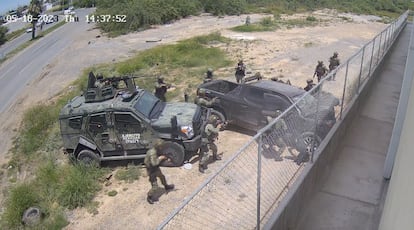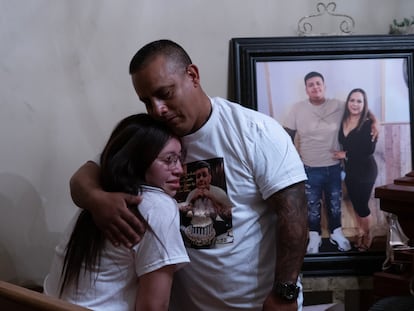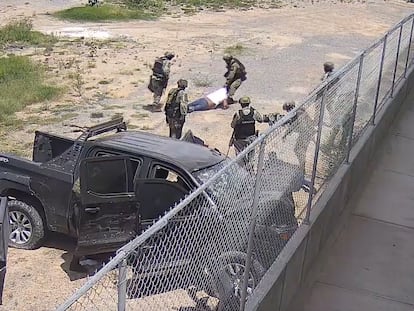Mexican soldier allegedly involved in the May killings in Nuevo Laredo: ‘I can identify the sergeant shooting at the civilians’
EL PAÍS has seen statements from security forces about the chaotic scene that left five people dead and implicated a colonel


The statements of six soldiers from Mexico’s 5th Special Forces Battalion, implicated in the alleged murder of five civilians in Nuevo Laredo (northern Mexico) on May 18, vividly describe the chaos of the operation that led to the killings. Soldiers defied orders and weapons malfunctioned while unidentified officers watched nearby. The statements obtained by EL PAÍS pertain to the ongoing investigation conducted by military prosecutors, initiated after EL PAÍS released a video on June 6 appearing to show soldiers firing at five civilians who had already been restrained.
Mexicans are used to accusations of human rights violations by its country’s security forces, but they don’t often see such compelling evidence of the abuses. The day after the video was released, President Andrés Manuel López Obrador acknowledged that “apparently there was an execution,” and stated that “these situations cannot be allowed.” A few days later, the Ministry of Defense (SEDENA) announced the arrests of 16 military personnel for offenses under military jurisdiction, while awaiting action from the Office of the Attorney General (FGR). On June 1, they replaced General Jorge González, the commander of the military garrison in the border city of Nuevo Laredo, and on June 21, they replaced Colonel Héctor Aldape, who leads the 16th Cavalry Regiment.
The military investigation documents reveal discrepancies in the two accounts provided by Lieutenant José Luis N. to his superiors and civilian authorities. According to his report to the civilian prosecutors, the lieutenant said that a black truck accelerated after seeing army vehicles approaching and later crashed. However, in his report to military authorities, he states that his unit was patrolling the extension of Monterrey Street when they encountered “aggression by armed civilians” at the corner of Emiliano Zapata Street, prompting them to initiate pursuit. Only one other soldier involved in the incident also said the civilians fired the first shots.
Of the six testimonies we reviewed, the statement from Sergeant B. J. stands out. He was in charge of one of the three vehicles involved in the operation. Using their full names, B. J. directly accused two fellow soldiers of shooting at the restrained civilians. Another significant revelation by Corporal D. V. claims that a colonel arrived with four other army vehicles just as a shootout was ending with armed civilians who were attempting to rescue their comrades. Although not explicitly mentioned by name in the statement, it is presumed to be Colonel Héctor Aldape. Prior to this revelation, the colonel’s alleged presence at the scene had not been disclosed.
Several statements reported that firearms jammed during the confrontation, jeopardizing their own lives as well as the lives of their fellow soldiers. Sergeant B. J.’s statement claims: “Individuals in a dark blue civilian vehicle, approximately 100 meters [109 yards] from our position, opened fire in our direction... My rifle bolt jammed, so I banged it on the ground to fix it.” Similarly, Corporal D. V. stated that Corporals Q. and C. valiantly fought back only to face similar problems with their firearms.
The military personnel involved in the incident belong to the 5th Special Forces Battalion based in Temamatla, near Mexico City. According to their statements, the operation began with a vehicle pursuit. Military forces have been deployed to Nuevo Laredo and Reynosa since April 3 to support regular security operations in the area. Seventeen soldiers reported seeing a black pickup truck that quickly fled after the occupants spotted the soldiers. It’s not clear whether the civilians in the truck fired any shots. Despite explicit orders from superior officers to avoid pursuits, all the statements confirmed that the soldiers chased the truck. The pursuit ended when the truck crashed into a wall behind a shopping center.
Following the crash, soldiers from three vehicles swiftly ordered the civilians out of the truck and disarmed them. They were beaten and restrained, and lined up next to the wall. Minutes later, soldiers reported being fired upon from an unidentified location to the north. At least seven soldiers were positioned near the crashed vehicle and the wall. Soldiers began firing in several directions, primarily toward the north and northwest. Two soldiers allegedly fired toward the wall and killed the civilians.
As the soldiers positioned near the wall fired back, 10 others in two armored vehicles — a Humvee and a Sand Cat — were fighting a group of armed civilians several hundred yards to the north. In the video, the Sand Cat initially appears next to the crashed black truck. After taking gunfire, it begins moving north up the street alongside the Humvee. All military personnel — those positioned to the north and the ones at the crashed truck — were supposedly targeting the same group of assailants, but the video doesn’t show any evidence of armed civilians firing at the soldiers near the shopping center wall.
B. J. and A. L.
Among the six statements we reviewed, Sergeant B. J.’s account stands out. He was responsible for one of the three vehicles — the Sand Cat. Sergeant B. J. explicitly accuses two colleagues, a corporal and another sergeant, of opening fire on unarmed and restrained civilians who were kneeling against the shopping center wall. These were the same individuals from the black truck that had crashed into the wall moments earlier. EL PAÍS has chosen not to name the accused individuals, who are currently presumed innocent.
“I saw Corporal J. G., who was positioned next to the front passenger side of the black truck, firing shots towards the civilians over the truck’s roof,” said Sergeant B. J. “I also saw Sergeant A. L., who was on the driver’s side of the truck near the wall, pull out a handgun and shoot at the civilians by the wall.” Sergeant B. J. identified the soldiers when the military prosecutor showed him the video. He then says that he didn’t realize what was happening at the time, because he was covering one of the three military vehicles (a Chevrolet Cheyenne pickup truck).
B. J.’s testimony is extraordinarily frank. In addition to identifying the two soldiers who fired at the civilians, he directly accuses Lieutenant José Luis N., the commanding officer on the ground that day, of placing previously confiscated weapons next to the lifeless bodies of the civilians, which can be seen in the video. B. J. also identified another soldier who assaulted the civilians after they were pulled from the crashed truck, which can also be seen in the video. For unknown reasons, the military prosecutor chose to show the video solely to Sergeant B. J., while withholding it from the other soldiers who were interviewed.
Sergeant A. L. is one of the individuals identified by B. J. who shot at the civilians. A. L.’s statement says nothing about this allegation. Along with Lieutenant N. and five soldiers, A. L. was aboard the Chevrolet Cheyenne truck that led the chase of the black truck. It was the first vehicle to arrive at the crash scene. A.L. and the others jumped out and aimed their weapons at the truck. “We gave them verbal commands to exit the vehicle, and identified ourselves as the Mexican Army and that we would respect their lives,” stated the sergeant.
Sergeant A. L.’s statement doesn’t reveal much more. As the unit’s medic, he says that Lieutenant N. ordered him to treat one of the civilians who had been injured in the crash. “Moments later, they began shooting at us from different directions, so we started repelling the attack. Reinforcements arrived and established a security perimeter,” he said, referring to Colonel Aldape’s men. “And then a Black Hawk helicopter arrived.” The statement says nothing about shots fired at civilians.
Colonel Aldape implicated
The alleged presence of Colonel Aldape at the scene just minutes later could be damning evidence. Aldape, who was accused in March of killing five unarmed youths who were returning home from a nightclub, is the highest-ranking officer at the scene that afternoon. Beyond the allegations of executions, the military forces under Aldape’s command may have committed additional crimes.
On June 6, EL PAÍS released a video of the incident that shows a soldier placing confiscated rifles beside the lifeless bodies of the civilians. Sergeant B. J. identified that soldier as Lieutenant José Luis N. It’s unclear whether Aldape was already at the scene when this happened, but the video suggests otherwise. Lieutenant N. placed the weapons next to the corpses between 2:54 and 2:56 p.m., about five minutes after the killings and before Aldape’s arrival.
The video shows that shortly after 4:00 p.m., with the Colonel and his team now at the scene, another sequence of events unfolded. The ambulance with the sole surviving civilian had already departed, leaving behind military personnel waiting for the prosecutors who would examine the area. That’s when several soldiers notice that one of the four dead civilians is still wearing handcuffs. A soldier quickly pulls out a key and takes them off. Presumably, Colonel Aldape was already there to see this.
Sign up for our weekly newsletter to get more English-language news coverage from EL PAÍS USA Edition
Tu suscripción se está usando en otro dispositivo
¿Quieres añadir otro usuario a tu suscripción?
Si continúas leyendo en este dispositivo, no se podrá leer en el otro.
FlechaTu suscripción se está usando en otro dispositivo y solo puedes acceder a EL PAÍS desde un dispositivo a la vez.
Si quieres compartir tu cuenta, cambia tu suscripción a la modalidad Premium, así podrás añadir otro usuario. Cada uno accederá con su propia cuenta de email, lo que os permitirá personalizar vuestra experiencia en EL PAÍS.
¿Tienes una suscripción de empresa? Accede aquí para contratar más cuentas.
En el caso de no saber quién está usando tu cuenta, te recomendamos cambiar tu contraseña aquí.
Si decides continuar compartiendo tu cuenta, este mensaje se mostrará en tu dispositivo y en el de la otra persona que está usando tu cuenta de forma indefinida, afectando a tu experiencia de lectura. Puedes consultar aquí los términos y condiciones de la suscripción digital.
More information
Archived In
Últimas noticias
Most viewed
- Sinaloa Cartel war is taking its toll on Los Chapitos
- Oona Chaplin: ‘I told James Cameron that I was living in a treehouse and starting a permaculture project with a friend’
- Reinhard Genzel, Nobel laureate in physics: ‘One-minute videos will never give you the truth’
- Why the price of coffee has skyrocketed: from Brazilian plantations to specialty coffee houses
- Silver prices are going crazy: This is what’s fueling the rally










































